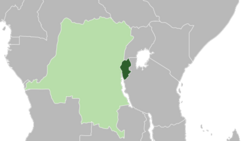Ruanda-Urundi
Ruanda-Urundi | |||||||||||
|---|---|---|---|---|---|---|---|---|---|---|---|
| 1922–1962 | |||||||||||
 Ruanda-Urundi (dark green) depicted within the Belgian colonial empire (light green), 1935. | |||||||||||
| Status | Mandate of Belgium | ||||||||||
| Capital | Usumbura | ||||||||||
| Common languages | French, Dutch (official) Also: Kirundi, Kinyarwanda | ||||||||||
| Religion | Roman Catholicism Also: Protestantism, Islam and others | ||||||||||
| History | |||||||||||
• Established | November 1 1922 | ||||||||||
| 1943-44 | |||||||||||
| November 1959-July 1962 | |||||||||||
• Independence | July 1 1962 | ||||||||||
| Currency | Belgian Congo franc (1916-60) Ruanda-Urundi franc (1960-62) | ||||||||||
| |||||||||||
| Today part of | |||||||||||
Ruanda-Urundi was a part of German East Africa under Belgian military occupation from 1916 to 1924. It was then a League of Nations class B mandate of Belgium from 1924 to 1945.
It transitioned to a United Nations trust territory (still Belgian) from 1945 until 1962, when it became the independent states of Rwanda and Burundi.
History
The independent Kingdoms of Rwanda and Burundi were annexed by Germany along with the other states of the Great Lakes region in the late 19th and early 20th centuries. Attached to German East Africa, the region had only a minimal German presence.
During the East African Campaign in World War I, the area was conquered by forces from the Belgian Congo in 1916.
League of Nations mandate

The Treaty of Versailles divided German East Africa with the vast majority known as Tanganyika going to Great Britain. The westernmost portion, which was formally referred to as the Belgian Occupied East African Territories, went to Belgium. In 1924, as the League of Nations issued a formal mandate that granted Belgium full control over the area, the area officially became Ruanda-Urundi.[1]
The Belgians were far more involved in the territory than the Germans, especially in Ruanda. Despite the mandate rules that the Belgians had to develop the territories and prepare them for independence, the economical policy practised in the Belgian Congo was exported eastwards: the Belgians demanded that the territories earn profits for the motherland and any development must come out of funds gathered in the territory. These funds mostly came from the extensive cultivation of coffee in the region's rich volcanic soils.
To implement their vision, the Belgians used the existing indigenous power structure. This consisted of a largely Tutsi ruling class controlling a mostly Hutu population. The Belgian administrators believed that the Tutsi were superior and deserved power. While before colonization the Hutu had played some role in governance, the Belgians simplified matters by further stratifying the society on racial lines. Hutu anger at the Tutsi domination was largely focused on the Tutsi elite rather than the distant colonial power.[2]

Although promising the League it would promote education, Belgium left the task to subsidised Catholic missions and unsubsidised Protestant missions. As late as 1961, shortly before independence arrived, fewer than 100 natives had gone beyond secondary school. The policy was one of low-cost paternalism, as explained by Belgium's special representative to the Trusteeship Council: "The real work is to change the African in his essence, to transform his soul, [and] to do that one must love him and enjoy having daily contact with him. He must be cured of his thoughtlessness, he must accustom himself to living in society, he must overcome his inertia."[3]
United Nations trust territory (1945-1962)
After the League of Nations was dissolved, the region became a United Nations trust territory in 1946. This included the promise that the Belgians would prepare the areas for independence, but the Belgians felt the area would take many decades to ready for self-rule.[4]
Independence came largely as a result of actions elsewhere. In the 1950s, an independence movement arose in the Belgian Congo, and the Belgians became convinced they could no longer control the territory. In 1960, Ruanda-Urundi's larger neighbour gained its independence. After two more years of hurried preparations, the colony became independent on July 1, 1962, broken up along traditional lines as the independent nations of Rwanda and Burundi. It took two more years before the government of the two became wholly separate.
Royal administrators
Royal Commissioners
- Justin Malfeyt (November 1916 – May 1919)
- Alfred Frédéric Gérard Marzorati (May 1919 – August 1926)
Governors (Deputy Governors-General of the Belgian Congo)
- Alfred Marzorati (August 1926 – February 1929)
- Louis Postiaux (February 1929 – July 1930)
- Charles Voisin (July 1930 – August 1932)
- Eugène Jungers (August 1932 – July 1946)
- Maurice Simon (July 1946 – August 1949)
- Léon Pétillon (August 1949 – January 1952)
- Alfred Boùùaert (January 1952 – March 1955)
- Jean-Paul Harroy (March 1955 – January 1962)
See also
References
- ^ William Roger Louis, Ruanda-Urundi 1884-1919 (Oxford U.P., 1963).
- ^ Peter Langford, "The Rwandan Path to Genocide: The Genesis of the Capacity of the Rwandan Post-colonial State to Organise and Unleash a project of Extermination". Civil Wars Vol. 7 n.3
- ^ Mary T. Duarte, "Education in Ruanda-Urundi, 1946-61, " Historian (1995) 57#2 pp 275-84
- ^ "Rwanda profile". BBC Online. 21 March 2014. Retrieved 30 May 2014.
Further reading
- Jean-Pierre Chrétien, The Great Lakes of Africa: Two Thousand Years of History, translated by Scott Straus.



